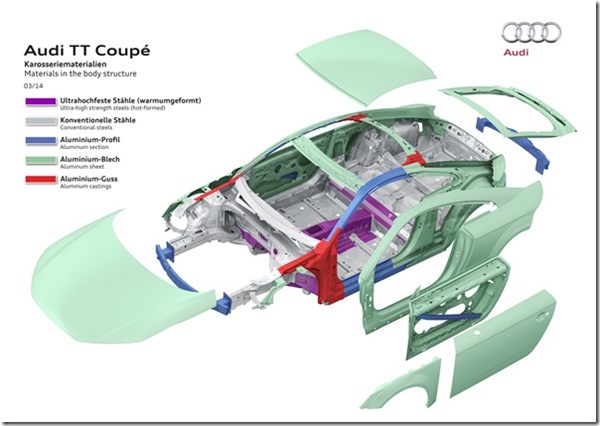A Cleaner Audi TT
You may recall the contaminated water emergency that occurred earlier this month in and around Toledo, Ohio.
#aluminum
You may recall the contaminated water emergency that occurred earlier this month in and around Toledo, Ohio. The cause were toxins generated by algae, which bloomed in abundance due to the run off of things like fertilizer and other chemicals.
It’s called “eutrophication.”
Which I didn’t know until I started reading about the forthcoming Audi TT and the lifecycle assessment that Audi has conducted on the coupe.

Said Prof. Dr. Ulrich Hackenberg, board member for Technical Development at Audi, “Our goal is to reduce significantly the overall emissions of each model compared with its predecessor. However, it’s not just a matter of what comes out of the exhaust pipe. At Audi, we look at the entire product and process chain associated with mobility.”
Turns out that nitrogen oxides can contribute to the potential of eutrophication, as well as petrochemical ozone creation and acidification.

Yes, this is in German, but you can probably figure out the steel and the aluminum. Or you can just use Google Translate.
One of the ways that Audi addresses environmental impacts with the new TT is through lightweight construction. The new car weighs 2711.69 lb., which is 110.23 lb. lighter than the car it replaces.
To achieve a light structure, the company is using high-strength and ultra-high-strength steels for the front end and underbody and aluminum for structural and add-on parts.
They reckon that in the manufacturing process for the TT they’re reducing greenhouse gas emissions by approximately 9%, or 1,763.7 lb., and that overall, the third-gen TT has a lifecycle savings 6.05 tons of greenhouse gases.
Were there more companies like Audi, chances are concerns about drinking water would be less of a consideration.
RELATED CONTENT
-
Increasing Use of Structural Adhesives in Automotive
Can you glue a car together? Frank Billotto of DuPont Transportation & Industrial discusses the major role structural adhesives can play in vehicle assembly.
-
The F-150 and Aluminum
As the launch of the 2019 Ram 1500 and the forthcoming release of the 2019 Chevy Silverado are heating things up in the full-size pickup truck segment, it is worthwhile to call out some materials engineering data related to the Ford F-150, the vehicle that, with the 2015 model year, arguably made a major shift in the segment because it was the vehicle that made the unthinkable a reality: a truck that uses aluminum for its body, box and other components.
-
2017 Audi Q7 3.0T quattro tiptronic
Here’s something important to know about the 2017 Audi Q7 as it is a vehicle that seats seven and, consequently, is likely to carry passengers: The Insurance Institute for Highway Safety has awarded it with the Top Safety Pick+ designation, which is the highest possible rating from IIHS for 2016.


.jpg;width=70;height=70;mode=crop)